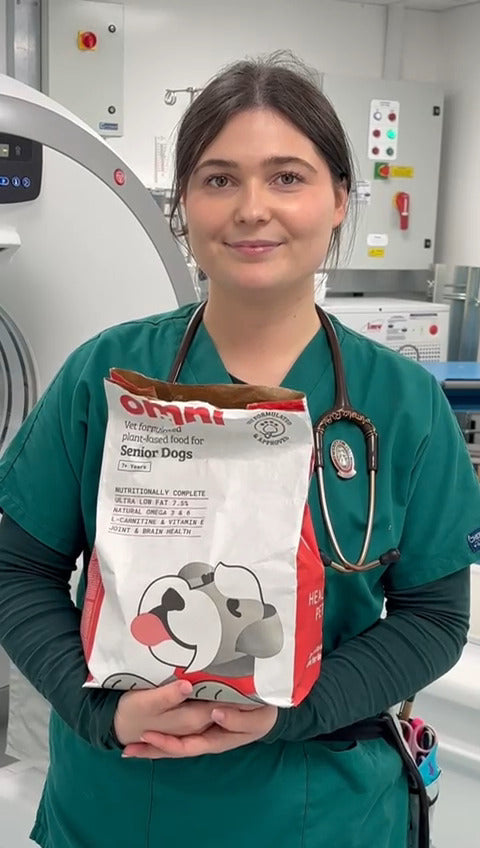Are Dogs Carnivores? A Vet’s Perspective

Are Dogs Carnivores? A Vet’s Perspective
Did you know that a paper published in the reputable journal ‘Nature’ found that dogs adapted to omnivorous diets alongside humans? (1)
Dogs were domesticated by humans over 10,000 years ago and as such adapted to eat what humans were eating. The study identified 36 genes that changed during the domestication of dogs from wolves, 10 of which play key roles in starch digestion and fat metabolism. This allowed dogs to thrive on starch rich diets alongside humans, where wolves could not. The study, and ones like it, are a large part of why dogs are now classified as omnivores, meaning they can access all the nutrients they need from a variety of sources, including plants.
Do dogs produce amylase?
-Do dogs produce salivary amylase?
A 2017 study showed that alpha-amylase can be reliably measured in the saliva of dogs (2).
- Do dogs produce pancreatic amylase?
Pancreatic amylase has indeed been shown to be part of nutrient digestion in the dog since the 1960s (12).
Do dogs have glucokinase?
The enzyme glucokinase is responsible for the first step of glycolysis (a way of getting energy from glucose). Dogs have high glucokinase activity, similar to omnivores rather than carnivores (3).
Do dogs have Type D taste buds?
Dogs do indeed have Type D taste buds, which are not found in cats and other carnivores, and these respond to ‘‘fruity-sweet’’ compounds (4).
Can dogs just be fed meat?
Meat alone is not nutritionally complete for a dog and diets rich in meat alone can be deficient in nutrients like calcium and vitamin D. Dogs fed on meat only diets can develop issues such as nutritional secondary hyperparathyroidism which can cause severe bone and mobility problems (13).
Can dogs digest plant proteins?
Dogs have also shown an excellent ability to digest plant proteins across many different studies (5 – 11) and studies have shown no difference in protein absorption as meat proteins are replaced with plant proteins in the dog (5).
What are carnivores and facultative carnivores?
Carnivores are different to omnivores in that almost all of their diet consists of meat and they often require meat to get complete nutrition as they need certain ‘preformed’ nutrients from meat that they cannot create themselves (making them an obligate carnivore) – this is the case for the cat. The term facultative carnivore is not well defined and has different descriptions depending on the source you read. The term is most often used on pro-carnivore sites to suggest that while omnivorous animals can utilise plant-based nutrients they believe they would be better eating a carnivorous diet.
Dog food
Contrary to what you may think, for a meat-based dog food product to be labelled as chicken or beef in the UK it only has to contain 4% meat. This means that lots of dog foods out there have been mostly vegetarian for decades. Instead of doing the same and bulking up the food with fillers like corn and white rice and various chemicals, at Omni we replaced processed meat and unwanted left overs with premium plant-powered ingredients that dogs love.
References
(1) Axelsson E., Ratnakumar A., Arendt M.L., Maqbool K., Webster M.T., Perloski M., Liberg O., Arnemo J.M., Hedhammar A., Lindblad-Toh K. (2013) The genomic signature of dog domestication reveals adaptation to a starch-rich diet. Nature; 495:360–364. doi: 10.1038/nature11837
(2) Contreras-Aguilar MD, Tecles F, Martínez-Subiela S, Escribano D, Bernal LJ, Cerón JJ. Detection and measurement of alpha-amylase in canine saliva and changes after an experimentally induced sympathetic activation. BMC Vet Res. 2017 Aug 22;13(1):266. doi: 10.1186/s12917-017-1191-4. PMID: 28830550; PMCID: PMC5568211.
(3) Ballard FJ. Glucose utilization in mammalian liver. Comp Biochem Physiol. 1965 Mar;14:437-43. doi: 10.1016/0010-406x(65)90218-5. PMID: 14314983.
(4) Kanazawa H. Fine structure of the canine taste bud with special reference to gustatory cell functions. Arch Histol Cytol. 1993 Dec;56(5):533-48. doi: 10.1679/aohc.56.533. PMID: 8129987.
(5) Christina Golder, James L Weemhoff, Dennis E Jewell (2020) Cats Have Increased Protein Digestibility as Compared to Dogs and Improve Their Ability to Absorb Protein as Dietary Protein Intake Shifts from Animal to Plant Sources 24;10(3):541. doi: 10.3390/ani10030541.
(6) Ingenpaß L, Abd El-Wahab A, Ullrich C, Kölln M, Ahmed MFE, et al. (2021) Nitrogen output in the urban environment using a vegetarian canine diet. PLOS ONE 16(9): e0257364. https://doi.org/10.1371/journal.pone.0257364
(7) C. L. Cargo-Froom, A. K. Shoveller, M. Z. Fan, 227 Apparent and true digestibility of minerals in animal and vegetable ingredient based adult maintenance dog food, Journal of Animal Science, Volume 95, Issue suppl_4, August 2017, Page 112, https://doi.org/10.2527/asasann.2017.227
(8) Venturini, KS, Sarcinelli, MF, Baller, MA, Putarov, TC, Malheiros, EB, Carciofi, AC. Processing traits and digestibility of extruded dog foods with soy protein concentrate. J Anim Physiol Anim Nutr. 2018; 102: 1077– 1087. https://doi.org/10.1111/jpn.12894
(9) R. C. Hill, C. F. Burrows, G. W. Ellison, J. E. Bauer, The effect of texturized vegetable protein from soy on nutrient digestibility compared to beef in cannulated dogs, Journal of Animal Science, Volume 79, Issue 8, August 2001, Pages 2162–2171, https://doi.org/10.2527/2001.7982162x
(10) Carciofi, A.C., Takakura, F.S., De-Oliveira, L.D., Teshima, E., Jeremias, J.T., Brunetto, M.A. and Prada, .F. (2008), Effects of six carbohydrate sources on dog diet digestibility and post-prandial glucose and insulin response. Journal of Animal Physiology and Animal Nutrition, 92: 326-336. https://doi.org/10.1111/j.1439-0396.2007.00794.x
(11) Julia Guazzelli Pezzali, Charles Gregory Aldrich, Effect of ancient grains and grain-free carbohydrate sources on extrusion parameters and nutrient utilization by dogs, Journal of Animal Science, Volume 97, Issue 9, September 2019, Pages 3758–3767, https://doi.org/10.1093/jas/skz237
(12) Behrman HR, Kare MR. Adaptation of canine pancreatic enzymes to diet composition. J Physiol. 1969 Dec;205(3):667-76. doi: 10.1113/jphysiol.1969.sp008989. PMID: 5361294; PMCID: PMC1348575.
(13) Lennart Krook, Joseph P. Whalen, Nutritional secondary hyperparathyroidism in the animal kingdom: report of two cases, Clinical Imaging, Volume 34, Issue 6, 2010, Pages 458-461, ISSN 0899-7071, https://doi.org/10.1016/j.clinimag.2010.08.010.







 85 Great Portland Street, 1st Floor, London, W1W 7LT United Kingdom
85 Great Portland Street, 1st Floor, London, W1W 7LT United Kingdom





